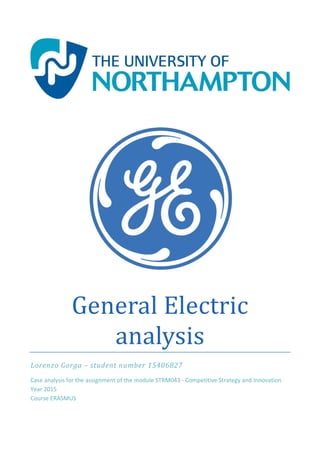
Case analysis
- 2. 1 General Electric analysis Index Executive summary ........................................................................................................................................... 2 1. I Question .................................................................................................................................................. 3 1.1. Resources........................................................................................................................................... 3 1.2. Capabilities ........................................................................................................................................ 4 1.3. Core Competences ............................................................................................................................ 6 1.4. Effectiveness ...................................................................................................................................... 6 2. II Question ................................................................................................................................................. 8 2.1. Strategic options ................................................................................................................................ 8 2.2. Strategy monitoring ......................................................................................................................... 10 3. III Question .............................................................................................................................................. 11 3.1. Welch VS Immelt ............................................................................................................................. 11 3.2. VUCA’s best manager ...................................................................................................................... 11 Reference list ................................................................................................................................................... 12 Bibliography ..................................................................................................................................................... 13
- 12. 11 General Electric analysis 3. III Question 3.1.Welch VS Immelt Immelt’s and Welch’s strategies are different in several aspects and most of them have already been explained in the previous paragraphs, therefore now it is enough to recapitalised them. Welch Immelt Guidance Immediate profit Long term growth Business of interest Finance Infrastructure Markets US, EU Emerging countries Focus Performance & efficiency (insight) Innovation (outsight) CSR ‐ Part of DNA Management style Pushing to limits Friendly Structure Delayering, more units Cross‐sections, less units Aim of acquisitions Diversification (being 1 or 2 in every business) Consistency (tech and innovation) Stakeholders of interest Shareholders Customers Main risks Scandals, too much pressure on employees Missing opportunities Contagion Coordination problems General source of advantage Cost leadership Differentiation Immelt’s vision is based on Welch’s work and the direction is always the growth of the company, obviously with different strategies because of the changing environment. It is possible to unite the two kind of leadership in the same Four Actions Framework, while Welch seems to be more focusses on Reducing and Eliminating; Immelt, because of the good implementation in these ambits by his predecessor, shifted the efforts in Creating and Raising (Pryce, 2015). This give continuity to the path of GE and, therefore, more consistency to Immelt’s strategy which seems to be perfectly settled between GE’s past and the future aimed. 3.2.VUCA’s best manager Immelt’s leadership had reoriented the focus from shareholder to stakeholder, with a long term vision and sustainability. The focus on innovation and the ability to understand global trends bring new opportunities. He is trying to simplify the structure and raise the internal collaboration and coordination. His leadership reflect the Grant’s New Model of Leadership, thanks to ability in build confidence, enthusiasm, cooperation, form networks, use information. All these are reason for Immelt to be considered a very suitable manager in the VUCA world (Pryce, 2015).